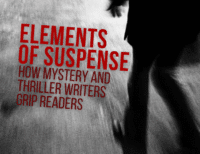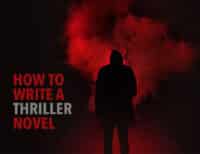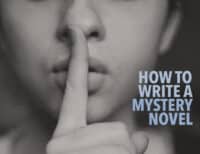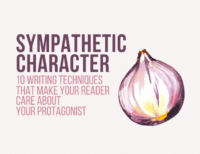If you want your readers to not just pick up your book, but keep turning the pages, you need to learn how to write a hook that will draw them through the story so they never want to put it down. Try baiting your hooks with the thrill of danger to keep your readers on the line.

Reading are tantalized by the scent of danger in our stories, and we’re able to enjoy it from the safety of our beds or beach chairs.
A good book that pulls us in deep might make us feel like the danger is real, and we often experience it as such, but we can indulge ourselves in it and savor that vicarious thrill because we’re in a protected zone.
Today, we’re going to explore how to use hooks baited with danger to snag and hold reader interest.
Danger Excites Readers with Action
Sometimes the most delectable danger in fiction is subtle and conveyed by covert means, as in psychological suspense. But more often, danger and action go together, the kind of action that carries risk.
For instance, a car moving down the street is action, but there’s no inherent danger attached to the movement, so it does nothing to hook the reader. But with a few adjustments, we can make that moving car into something dangerous indeed.
Put a small child behind the wheel, a four-year-old playing around in the driver’s seat who happened to release the brake. Or maybe the automobile is squealing along with six cop cars in pursuit. Maybe it’s three o’clock in the morning, the streets are deserted, and the car is the only thing that’s moving, pinning the protagonist in its headlights.
It takes more than action to create the danger hook. It must be action that makes you sit up and take notice.
Remember Reader Expectation
Most of us can recognize action when we see it on the page, so I’m not going to spend a lot of time on that sort of danger hook—bullets flying, villains chasing, karate chops raining down.
That type of clear and present danger provides a strong hook to carry the reader forward, but it fades fast, so you need to be ready with another hook.
In this article, I’ll spend time focusing on the more subtle varieties of danger hooks. As always, it’s vital to consider genre and reader expectations when crafting your danger hook. Different types of readers will perceive the hook in different ways. You want to be sure you’re baiting your hook to capture your target audience.
Ask yourself—will my core readers feel danger when they read this sentence? When a reader picks up a suspense or thriller, for instance, they expect to encounter danger. Readers make assumptions based on their expectations, so if I ended a scene like this:
“He knows where to find me.”
Seasoned readers of suspense fiction will attach sinister meaning to the phrase. They will find it dangerous, while readers who don’t normally read taut mysteries and thrillers won’t necessarily process it the same way.
Taken at face value, there’s no danger hook—he knows where to find me. So what?
Use the Right Bait to Reel in Your Reader
As you increase the number of hooks in the passage, the tension builds and the pacing accelerates. Be sure you are using an appropriate amount for your audience (or the appropriate type of tension). Cozy readers aren’t looking for a fast-paced adventure, so scale back. Always think about who you’re writing for, and write to that target.
While most readers will respond favorably to a degree of danger in their story, make sure you dial it up or down to suit your audience. And the focus will change, as well.
For example, readers who prefer a more literary tale will want to focus on the character’s emotional response, while readers who are expecting a light romance or caper will be more interested in getting to what happens next.
Let’s Take a Look at Some Examples
“Decorations had to be set up, food had to be arranged. She wanted the room to be as nice as possible for the two hundred CCCBA members who’d been looking forward to the party for months.” Fast, Jeffery Deaver
Do you see the danger here? No, I didn’t think so. I use this as an interesting example of how the danger hook works in context, depending on reader expectation and information flow. As it stands, there is no danger, and no hook. However, when I show you the hook that opens the story:
“They were just about to see the octopus when she received a text alerting her that two hundred people were going to die in two hours.”
Now you see the danger. It's not only in the hook contained in this opening sentence, but when Deaver closes the later scene with my first example, the innocuous paragraph turns deadly dangerous—those two hundred people at the party are going to die.
Notice how he weaves in a number of Raising Question hooks, too. Who’s going to die? How are they going to die? What can be done to stop it happening? What’s with the octopus?
Here Are Some More Examples:
“A few miles to the east as the crow flies, in a lost village in the Sabarthes Mountains, a tall, thin man in a pale suit sits alone at a table of dark, highly polished wood.” Labyrinth, Kate Mosse
This example opens the second chapter in the book. Nothing has come before to set it up, as in the last example, but because readers who pick up Labyrinth are expecting a tense story full of peril, they’ll read danger into this sentence, making it a pretty good hook. Note how the author threads in words that impart a somber tone—lost village, pale suit, dark polished wood.
“'You’ve heard of Pavlov’s dogs,' the man said. He wore a blood-streaked apron and a crooked smile. ‘These fellows put them to shame.'” Furrows, Joslyn Chase
The danger can be inherent, like the runaway car I mentioned earlier, or implied, like in the above example. This paragraph is the opening to a horror story, so when the reader sees the blood-streaked apron and crooked smile and thinks about animals trained to salivate at the ring of a bell, danger alarms go off.
“When I get to the steps of my lakeside home, the door is open. I slowly walk in, my hand reaching for the phantom weapon at my side, everything about me extended and tingling as I enter the strange place that used to be mine.” The Dark Snow, Brendan DuBois
This is the story opener, and though nothing much is actively happening, we feel the danger along with the protagonist. And, again, we have hooks working in tandem with other hooks. The opening raises many questions which the reader will want to have answered, drawing him forward into the next paragraph and beyond.
5 Tips for How to Write a Danger Hook
If you ask, “Will my target reader feel danger when reading this sentence or paragraph?” and can answer in the affirmative, you have a danger hook. But there are a few things to keep in mind to ensure you’ve made it the best it can be.
- Use strong verbs and surprising actions.
- The danger can be inherent or implied.
- Always keep reader expectations and genre considerations in mind.
- If you use the same danger/action hook again, later in the story, you’ll have to escalate or innovate or the effect will be diluted.
- When using a danger hook for the opening of a story, it has nothing to stand on, no prior context to draw upon, so it must stand on its own merit.
A Case in Point
Let’s examine the ending of a scene from my thriller, Nocturne In Ashes. What if I’d written it like this in my first draft:
A radio call came through, but no one picked up.
Okay, not terrible, but it’s a waste of a good opportunity for a strong danger hook. Let’s see what we can do to shape it up.
In the empty Explorer, the radio squawked, but no one picked up.
Now we’ve got a strong and descriptive verb—squawked. And the Explorer is empty, a word that implies desolation and perhaps something gone horribly wrong, given the context and the genre, which gives us a flavor of the setting. Here’s the published version.
“In the empty Explorer, the two-way radio squawked, demanding attention. No one heard and no one answered.” Nocturne In Ashes, Joslyn Chase
Now, we’ve got the terms “two-way radio” and “demanding attention,” which carry implications to the reader’s brain. One party is urgently attempting to reach another party without success. “No one heard, and no one answered” drives home the possibility that something dire is happening. Danger is in the air.
Look for Opportunity
If you haven’t built hooks into your manuscript, don’t despair. On revision, look for opportunities to create or strengthen hooks. And remember to use hooks in combination with other hooks. So far, we’ve studied the Raising Question hook and the Danger hook, but there are many more.
If you want to learn more about hooks, a great resource is Mary Buckham’s book Writing Active Hooks.
Have fun with this. Remember what it felt like to create a sense of danger in the games we played as children. Go play with some danger hooks and reel in your target readers.
How about you? Do you love stories with a flavor of danger? Do you see how the Danger Hook might strengthen your writing? Tell us about it in the comments.
PRACTICE
Let’s have some fun developing a straightforward sentence into a danger hook. Use this as the basis of the exercise:
Sally walked down the stairs and switched on the light.
There’s no danger hook here, but you can change all that. Remember to use words that carry connotations, imparting meaning with economy. Strong verbs, descriptive nouns. Keep it tight. Think about the setting and be creative about where the danger lies. Feel free to add another sentence or two if you need it, but remember that you want the power to be concentrated, so don’t wander.
Have fun! Write for fifteen minutes, adding and subtracting, choosing just the right words, until you’ve crafted the strongest hook possible. Then post your work in the comments section and be sure to provide feedback for your fellow writers!







0 Comments
Trackbacks/Pingbacks